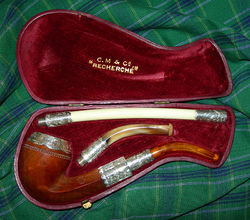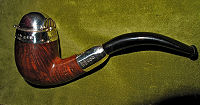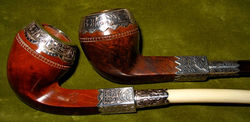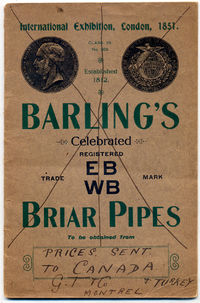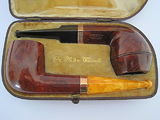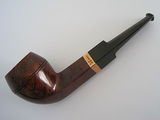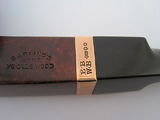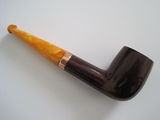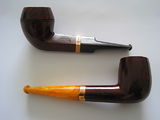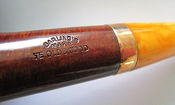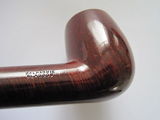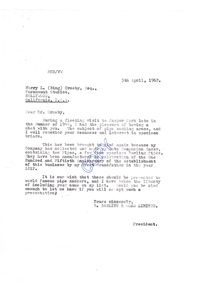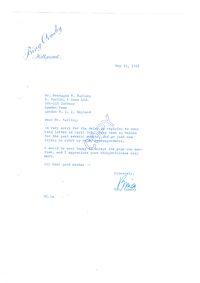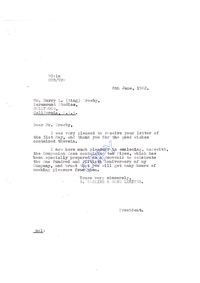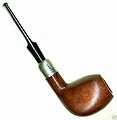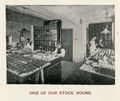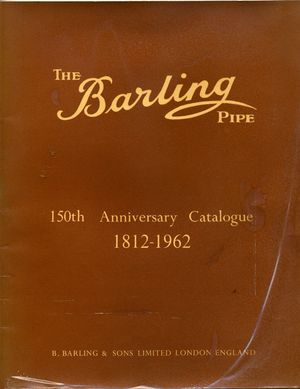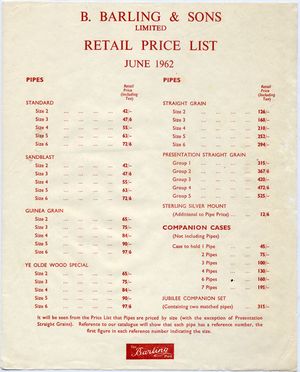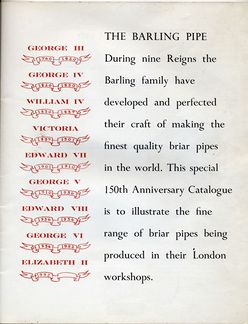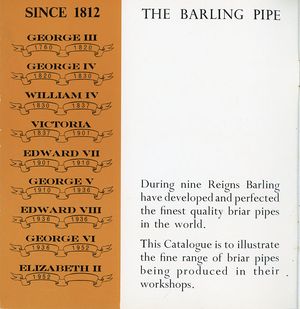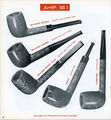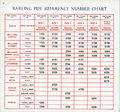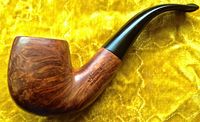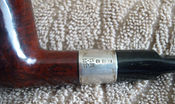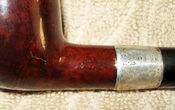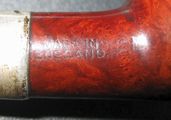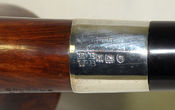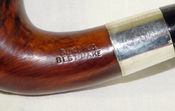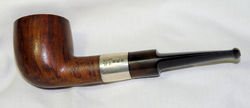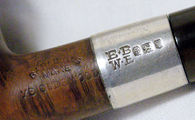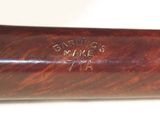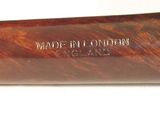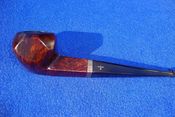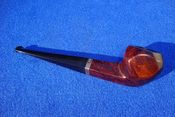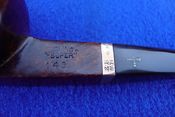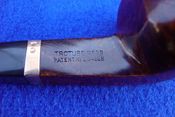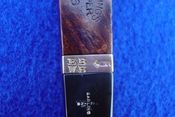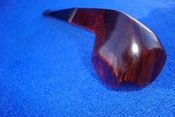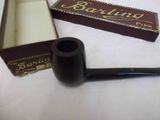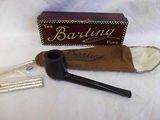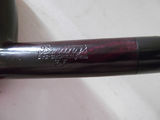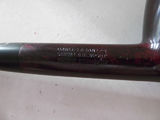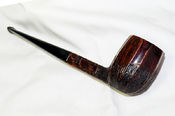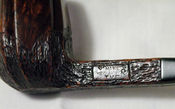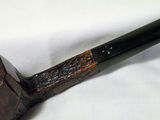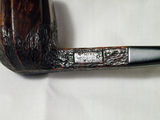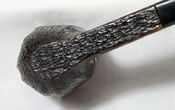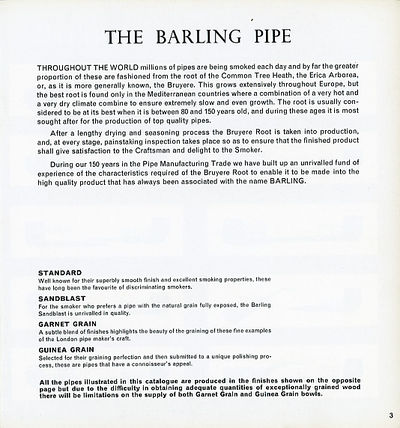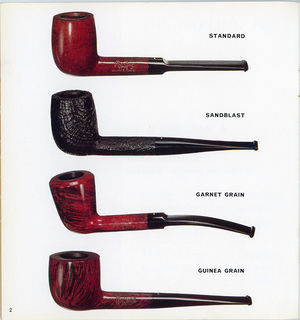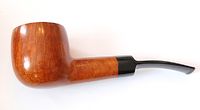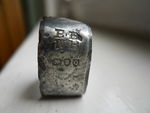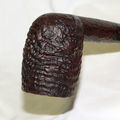Barling: Difference between revisions
No edit summary |
|||
| Line 12: | Line 12: | ||
== The Company == | == The Company == | ||
[[File:Barlings_Pre_long2.jpg|thumb|250px|left|Pre-Barling by Crown of Vienna, silver work by the Barling family of London, and stamped with E.B. and W.B. stamps, albatross wing bone extensions. From the Johnny Long Collection]][[File:Barlings_long1.jpg|thumb|200px|Stamped "BARLING'S MAKE", London 1906, Rd. No. 458002, from the Johnny Long Collection]][[File:Barling_silver_bands.gif|thumb|200px|From Left: 1927-Tetley's; 1916 w/Military bit; 1956-Tetley's; Pre-Trans EXEL T.V.F, Derek Green Collection[http://www.derek-green.com/Others.htm]]][[File:Barlings_pre_Long4.jpg|thumb|left|250px|Pair of uncased 1884s with E.B. W.B stamped Barling silverwork]][[File:Barling_Catalogue_Cover.jpg|thumb|200px|right|B. Barling & Sons catalogue of pipes - Printed by Unwin Brothers - The Gresham Press - likely dated 1922, Courtesy Jesse Silver]][[File:Barlings_pre_Long3.jpg|thumb|250px|left|1884, upper pipe from above pair. It has screw mounts and also has the wing bone extension. From the Johnny Long Collection]][[File:Barlings_pre_Long3b.jpg|thumb|250px|left|1884 screw mount detail. From the Johnny Long Collection]] '''''“We have much pleasure in presenting our New Catalogue illustrating some of the principal shapes and specialities in our celebrated EB WB Briar Pipes.'''''<br> | [[File:Barlings_Pre_long2.jpg|thumb|250px|left|Pre-Barling by Crown of Vienna, silver work by the Barling family of London, and stamped with E.B. and W.B. stamps, albatross wing bone extensions. From the Johnny Long Collection]][[File:Barlings_long1.jpg|thumb|200px|Stamped "BARLING'S MAKE", London 1906, Rd. No. 458002, from the Johnny Long Collection]][[File:Barling_silver_bands.gif|thumb|200px|From Left: 1927-Tetley's; 1916 w/Military bit; 1956-Tetley's; Pre-Trans EXEL T.V.F, Derek Green Collection[http://www.derek-green.com/Others.htm]]][[File:Barlings_pre_Long4.jpg|thumb|left|250px|Pair of uncased 1884s with E.B. W.B stamped Barling silverwork]][[File:Barling_Catalogue_Cover.jpg|thumb|200px|right|B. Barling & Sons catalogue of pipes - Printed by Unwin Brothers - The Gresham Press - likely dated 1922, Courtesy Jesse Silver]][[File:Barlings_pre_Long3.jpg|thumb|250px|left|1884, upper pipe from above pair. It has screw mounts and also has the wing bone extension. From the Johnny Long Collection]][[File:Barlings_pre_Long3b.jpg|thumb|250px|left|1884 screw mount detail. From the Johnny Long Collection]]'''''“We have much pleasure in presenting our New Catalogue illustrating some of the principal shapes and specialities in our celebrated EB WB Briar Pipes.'''''<br> | ||
'''''Our pipes being so well known and universally known (without the artificial aid of advertisements), we will not here dwell on their perfection, but would ask you to kindly peruse this book, which will no doubt introduce to you some new patterns.'''''<br> | '''''Our pipes being so well known and universally known (without the artificial aid of advertisements), we will not here dwell on their perfection, but would ask you to kindly peruse this book, which will no doubt introduce to you some new patterns.'''''<br> | ||
'''''If you are not already a smoker of our pipes, we hope that it will lead to your giving them a trial and thus testing their quality and workmanship, we ourselves being confident of your ultimate judgment and satisfaction. Every department of our factory being under our own practical and personal supervision, ensures every pipe turned out by us coming under our direct notice. This fact, coupled with the excellence of the materials used in their manufacture, has given our pipes a reputation second to none in the smoking world, a reputation we firmly intend to maintain and strengthen.''''' | '''''If you are not already a smoker of our pipes, we hope that it will lead to your giving them a trial and thus testing their quality and workmanship, we ourselves being confident of your ultimate judgment and satisfaction. Every department of our factory being under our own practical and personal supervision, ensures every pipe turned out by us coming under our direct notice. This fact, coupled with the excellence of the materials used in their manufacture, has given our pipes a reputation second to none in the smoking world, a reputation we firmly intend to maintain and strengthen.''''' | ||
| Line 31: | Line 31: | ||
In their single-minded pursuit of perfection, B. Barling and Sons used only the very choicest of old growth air seasoned Algerian briar. “Legendary” is the term most often applied to the smoking properties of these pipes. | In their single-minded pursuit of perfection, B. Barling and Sons used only the very choicest of old growth air seasoned Algerian briar. “Legendary” is the term most often applied to the smoking properties of these pipes. | ||
Richard Carleton Hacker is the author of numerous books on collectible and historic pipes including Rare Smoke - The Ultimate Guide To Pipe Collecting. According to Hacker, the Barling family sold the company to the Imperial Tobacco Company in 1960. However, Tad Gage states that the year was 1962. Peter Macnab, writing about the history of the company for Tobacco Magazine in 1982 gives the year as 1961 when B. Barling & Sons was sold to Finlay’s, their largest customer and a part of the Imperial Tobacco group. | <center><gallery widths=175 perrow=4 caption="A Beautiful 1917 cased set, courtesy Alex Lee - Scotland"> | ||
File:Barlings 1917set03.jpg | |||
File:Barlings 1917set05.jpg | |||
File:Barlings 1917set06.jpg | |||
File:Barlings 1917set09.jpg | |||
File:Barlings 1917set11.jpg | |||
File:Barlings 1917set12.jpg | |||
File:Barlings 1917set13.jpg | |||
</gallery></center> | |||
[[Image:1909SilverSpigot.jpg|thumb|200px|Barling 1909 Silver Spigot Billiard, Courtesy [http://www.finepipes.com/english.php?pipemakerID=25 Finepipes.com]]][[Image:BalringBent.jpg|thumb|200px|Barling c. 1930 EXEXEL-Sized Classic Bent Billiard, courtesy, [http://www.finepipes.com/english.php?pipemakerID=25 FinePipes.com]]][[Image:Barling_pre_lovat.jpg|thumb|200px|Pre-trans Lovat, [http://smokershaven.com Smokershaven.com]]]Richard Carleton Hacker is the author of numerous books on collectible and historic pipes including Rare Smoke - The Ultimate Guide To Pipe Collecting. According to Hacker, the Barling family sold the company to the Imperial Tobacco Company in 1960. However, Tad Gage states that the year was 1962. Peter Macnab, writing about the history of the company for Tobacco Magazine in 1982 gives the year as 1961 when B. Barling & Sons was sold to Finlay’s, their largest customer and a part of the Imperial Tobacco group. | |||
Regardless of the year of the sale, the Barling family was running the company in 1962. Montague Barling was still the president of the company and Williamson Barling was still the general manager, a position in which he would continue to1967. | Regardless of the year of the sale, the Barling family was running the company in 1962. Montague Barling was still the president of the company and Williamson Barling was still the general manager, a position in which he would continue to1967. | ||
| Line 37: | Line 47: | ||
It has recently come to light that letters exist, which were written by Montague Barling from the period of April thru June of 1962, during which time the Barling Company presented pipes to celebrity pipe smokers to celebrate the 150th anniversary of the company. We have included a sample of that correspondence in the form of an exchange of letters between Mr. Barling and Bing Crosby. Montague Barling’s stationery clearly bears the imprint of “President”. On the basis of this evidence we can set aside the 1960 sale date in favor of either late 1961 or 1962. | It has recently come to light that letters exist, which were written by Montague Barling from the period of April thru June of 1962, during which time the Barling Company presented pipes to celebrity pipe smokers to celebrate the 150th anniversary of the company. We have included a sample of that correspondence in the form of an exchange of letters between Mr. Barling and Bing Crosby. Montague Barling’s stationery clearly bears the imprint of “President”. On the basis of this evidence we can set aside the 1960 sale date in favor of either late 1961 or 1962. | ||
<gallery> | <center><gallery widths=200 heights=300> | ||
File:Bing Barling1.jpg|1962 Letter, From Montague Barling to Bing, Courtesy Peter Ashton | File:Bing Barling1.jpg|1962 Letter, From Montague Barling to Bing, Courtesy Peter Ashton | ||
File:Bing Barling3.jpg|1962 Letter, From Bing to Montague Barling, Courtesy Peter Ashton | File:Bing Barling3.jpg|1962 Letter, From Bing to Montague Barling, Courtesy Peter Ashton | ||
File:Bing Barling2.jpg|1962 2nd Letter, From Montague Barling to Bing, Courtesy Peter Ashton | File:Bing Barling2.jpg|1962 2nd Letter, From Montague Barling to Bing, Courtesy Peter Ashton | ||
</gallery> | </gallery></center> | ||
It’s worth quoting Montague Barling’s letter at this point: | It’s worth quoting Montague Barling’s letter at this point: | ||
| Line 64: | Line 74: | ||
== The periods == | == The periods == | ||
According to current scholarship, the Barling has gone through three distinct periods, which dramatically effect collectability of the pipes. These are referred to as the Pre-Transition, Transition, and Post Transition periods. The "Pre-Transition" pipes are highly sought after by collectors and have excellent smoking and aesthetic qualities. These pipes are famous for the "old wood" from which they were made. | |||
There is also a group of collectors who suggest that there are two Transition periods, based on quality rather than ownership of the company. These collectors hold that there was a noticeable inconsistency in quality beginning around 1954. Transition 1runs from 1954 to 1962 and Transition 2 runs from 1962 to 1968. The problem with this system is that the subtle inconsistencies are not noticeable on pipes that have seen 60+ years of use. It is pretty well ignored by Barling Pipe collectors. | There is also a group of collectors who suggest that there are two Transition periods, based on quality rather than ownership of the company. These collectors hold that there was a noticeable inconsistency in quality beginning around 1954. Transition 1runs from 1954 to 1962 and Transition 2 runs from 1962 to 1968. The problem with this system is that the subtle inconsistencies are not noticeable on pipes that have seen 60+ years of use. It is pretty well ignored by Barling Pipe collectors. | ||
| Line 95: | Line 105: | ||
====The 1962 150th Anniversary and Retailers’ Catalogs==== | ====The 1962 150th Anniversary and Retailers’ Catalogs==== | ||
[[File:Price List scaled.jpg|thumb|200|150th Anniversary Catalog Pricelist]]In 1962 the B. Barling and Sons Company issued not one, but TWO complete catalogs. The differences between these two catalogs are striking enough to warrant comment here. Their contents may legitimize altering the current definition of what constitutes a Pre-Transition, or Family Era, Barling. Or, at the very least, offer a reason to create a new period, Early Transition. | [[File:Barling 150th Cat Cover scaled.jpg|thumb|left|150th Anniversary Catalog Cover]][[File:Price List scaled.jpg|thumb|200|150th Anniversary Catalog Pricelist]]In 1962 the B. Barling and Sons Company issued not one, but TWO complete catalogs. The differences between these two catalogs are striking enough to warrant comment here. Their contents may legitimize altering the current definition of what constitutes a Pre-Transition, or Family Era, Barling. Or, at the very least, offer a reason to create a new period, Early Transition. | ||
The earlier of these two Catalogs, is the 150th Anniversary Catalogue.<br> | The earlier of these two Catalogs, is the 150th Anniversary Catalogue.<br> | ||
| Line 103: | Line 113: | ||
Under the current definition of a Pre-Transition pipe, these pipes, made from specially aged briar of the finest quality to celebrate the 150th anniversary, are transition pipes because their model numbers are designated as “Transition”. Time for a change? | Under the current definition of a Pre-Transition pipe, these pipes, made from specially aged briar of the finest quality to celebrate the 150th anniversary, are transition pipes because their model numbers are designated as “Transition”. Time for a change? | ||
It is in the 150th Anniversary catalog that the new numbering system first appears. The new numbering system was introduced while the Barling family ran the business. The price list explains that the new number designates size. | It is in the 150th Anniversary catalog that the new numbering system first appears. The new numbering system was introduced while the Barling family ran the business. The price list explains that the new number designates size. | ||
| Line 120: | Line 130: | ||
The catalog contains a listing of grades. From bottom to top these grades are: standard, sandblast (referred to as “fossil” in the stampings), Guinea Grain, Ye Olde Wood Special, Straight Grain, and Presentation Straight Grain. None of the previously published material from third party sources mentions that there were TWO grades of straight grain! | The catalog contains a listing of grades. From bottom to top these grades are: standard, sandblast (referred to as “fossil” in the stampings), Guinea Grain, Ye Olde Wood Special, Straight Grain, and Presentation Straight Grain. None of the previously published material from third party sources mentions that there were TWO grades of straight grain! | ||
In November of 1962 B. Barling and Sons published another full catalog. The differences between the two are instructive. | In November of 1962 B. Barling and Sons published another full catalog. The differences between the two are instructive. | ||
| Line 140: | Line 149: | ||
File:1962 retailers' cat sample logo detail.jpg|1962 retailers Catolog Sample Logo | File:1962 retailers' cat sample logo detail.jpg|1962 retailers Catolog Sample Logo | ||
File:1962 retailers' cat sample page 300dpi.jpg|1962 retailers Catolog Sample Page | File:1962 retailers' cat sample page 300dpi.jpg|1962 retailers Catolog Sample Page | ||
File:1962 Barling Retailers' Cat size chart.jpg|1962 retailers Catolog Size Chart | File:1962 Barling Retailers' Cat size chart.jpg|1962 retailers Catolog Size Chart | ||
</gallery></center> | </gallery></center> | ||
| Line 157: | Line 165: | ||
===Pre-Transition 1812 - 1962=== | ===Pre-Transition 1812 - 1962=== | ||
The Barling family controlled production up till this point. Quality was excellent, however some sources indicate a marked inconsistency in quality starting as early as 1954.<br> | [[Image:BarlingBent.jpg|thumb|200px|A pre-transition Barling bent exhibiting better than average grain, Courtesy of Mike Ahmadi ]][[Image:BarlingBentFossil.jpg|thumb|200px|Pre-Transition Barling Bent Fossil, which are very rare. Note the wonderful sandblast, Courtesy of Mike Ahmadi]][[Image:BarlingSpecial.jpg|thumb|200px|Pre-Transition Barling Special, Courtesy of Mike Ahmadi]]The Barling family controlled production up till this point. Quality was excellent, however some sources indicate a marked inconsistency in quality starting as early as 1954.<br> | ||
These pipes were made from old growth “extra extra” grade Algerian briar, of a quality no longer available. Barling conducted their own harvesting operations, looking for roots that ranged from 80 - 150 years of age. While many find the grain to be beautiful, this was not the aim of the Barling Company, and many of their pipes have rather unremarkable grain. The Barling Company’s intent was simple, to create the finest smoking instruments in the history of the world. Many connoisseurs believe that they achieved that goal admirably. | These pipes were made from old growth “extra extra” grade Algerian briar, of a quality no longer available. Barling conducted their own harvesting operations, looking for roots that ranged from 80 - 150 years of age. While many find the grain to be beautiful, this was not the aim of the Barling Company, and many of their pipes have rather unremarkable grain. The Barling Company’s intent was simple, to create the finest smoking instruments in the history of the world. Many connoisseurs believe that they achieved that goal admirably. | ||
| Line 167: | Line 175: | ||
According to Tad Gage, Pre-1946 stampings are minimal. No size, shape numbers, or even grading appears on most pipes before World War II. Of course there are exceptions and we have included images of a Barling pipe with 1922 hallmarks that clearly shows an “EL” stamp and a “MADE IN ENGLAND” stamp. While one is tempted to speculate that the sterling olive could have been placed on a much later pipe, the “BARLING’S MAKE” stamp is correct for this period. | According to Tad Gage, Pre-1946 stampings are minimal. No size, shape numbers, or even grading appears on most pipes before World War II. Of course there are exceptions and we have included images of a Barling pipe with 1922 hallmarks that clearly shows an “EL” stamp and a “MADE IN ENGLAND” stamp. While one is tempted to speculate that the sterling olive could have been placed on a much later pipe, the “BARLING’S MAKE” stamp is correct for this period. | ||
<center><gallery perrow=4 caption="1922 hallmarked pipe with the “EL” stamping, Jesse Silver Collection"> | <center><gallery widths=175 perrow=4 caption="1922 hallmarked pipe with the “EL” stamping, Jesse Silver Collection"> | ||
File:1922 EL barling1.JPG | File:1922 EL barling1.JPG | ||
File:1922 EL Barling2.JPG | File:1922 EL Barling2.JPG | ||
| Line 183: | Line 191: | ||
An interesting briar calabash shape from 1908 features the dealer’s name on the LH side with the “BARLING’S MAKE” stamp on the verso in a secondary placement. Since Gage suggests that the Barling Company didn’t begin exclusively turning its own bowls until some time around 1909, this may represent one of the earliest pipes made entirely by the Barling Company. Instead of the famous “MADE IN ENGLAND.” the word “ENGLND” is placed below the “BARLING’S MAKE” stamp. There is no crossed Barlings logo on the stem. | An interesting briar calabash shape from 1908 features the dealer’s name on the LH side with the “BARLING’S MAKE” stamp on the verso in a secondary placement. Since Gage suggests that the Barling Company didn’t begin exclusively turning its own bowls until some time around 1909, this may represent one of the earliest pipes made entirely by the Barling Company. Instead of the famous “MADE IN ENGLAND.” the word “ENGLND” is placed below the “BARLING’S MAKE” stamp. There is no crossed Barlings logo on the stem. | ||
<center><gallery caption="1908 Calabash Shaped Briar Pipe"> | <center><gallery widths=175 caption="1908 Calabash Shaped Briar Pipe, Jesse Silver Collection"> | ||
File:B_Calabash2.jpg | |||
File:B_Calabash5.jpg | |||
File:B_Calabash6.jpg | |||
File:B_Calabash7.jpg | |||
</gallery></center> | </gallery></center> | ||
Sometime around 1913, the “Ye Olde Wood” stamp makes its appearance on selected pipes. An example exists stamped on a 1913 date hallmarked pipe. This logo will continue to be used in the decades to come. Eventually, “Ye Olde Wood” will be stamped on nearly every pipe made and will come to represent the company to the world. | |||
< | <center><gallery widths=250> | ||
File: | File:1913_YOW_1.jpg|1913 Ye Olde Wood, Jesse Silver Collection | ||
File: | File:1913_YOW2.jpg|1913 Ye Olde Wood, Jesse Silver Collection | ||
File: | </gallery></center> | ||
</Gallery> | It is not known when the crossed Barling stem logo first appeared, but an example exists on a pipe with a 1923 date hallmark. | ||
During the 1930’s the “Barling’s Make” logo undergoes a style change, smaller in size with simpler block lettering. Model numbers will occasionally be stamped below the logo. These model numbers may be 4 digits beginning with a 1 for the English and European market. For the “overseas” market 3 digits, 2 digits and a letter, or 2 digits will be used. The “MADE IN ENGLAND.” stamp is also in use. As with all things related to the Barling nomenclature there are variations. Sometimes there is no “MADE IN ENGLAND.” stamp. Examples exist with a “MADE IN LONDON” over “ENGLAND” stamp. And, there are examples with “MADE IN ENGLAND” with no period after the word “ENGLAND”. | |||
<center><gallery Widths=175> | |||
File:'30's_barling3.jpg|Unusual '30s era markings, Jesse Silver Collection | |||
File:'30's_barling5.jpg|Unusual '30s era markings, Jesse Silver Collection | |||
</Gallery></center> | |||
In the ‘1920’s the Barling Company experimented with an aluminum tube pipe called a “trotube”. | |||
<center><gallery Widths=175 caption="1927 Tro-Tube quaint, A striking example of a spectacularly rare pipe, courtesy Kevin Chapman via Jesse Silver"> | |||
File:Barling trutube1.JPG | |||
File:Barling trutube2.JPG | |||
File:Barling trutube3.JPG | |||
File:Barling trutube4.JPG | |||
File:Barling trutube5.JPG | |||
File:Barling trutube6.JPG | |||
</gallery></center> | |||
In | In the 1930’s Barling produced a different line of filter pipes called the Pipet.<br> | ||
The | Later the Pre-Transition company made a line of filtered pipes called the “CYG-Smoker”. The CYG-SMOKER line of pipes also used the same script logo as appears on the Guinea Grain grade of pipes. | ||
<center><gallery widths=175 caption="The Cyg Smoker, a filtered pipe that Barling produced, Courtesy Douglas Holloway via Jesse Silver"> | |||
<gallery | File:Barling CygSmoker1.JPG | ||
File:Barling | File:Barling CygSmoker2.JPG | ||
File: | File:Barling CygSmoker3.JPG | ||
File: | File:Barling CygSmoker4.JPG | ||
</gallery></center> | |||
[[Image:GuineaGrainBent.jpg|thumb|200px|A "Barling's Guinea Grain" bent pipe. Note the wonderful straight grain - Courtesy of Mike Ahmadi]]A script “Barling’s” logo is used for the Pre-Transition Guinea Grain grade. In addition to the script “Barling’s” logo the pipes hare an “EB” and “Regd” stampings. | |||
And, horror of horrors, there are a few Pre-Transition pipes that have a script “Barling” logo. | |||
Also according to Tad Gage, the only four-digit number that denotes a Pre-Transition piece begins with "1," which was used for pipes sold in England. Any other four-digit Barling pipe is a Transitional piece-- (Tad Gage in P & T magazine). Pipes intended for non-European markets have a 3-digit number. However, Pre-Transition Barlings may have two numbers, not just three, and they may also have a letter following the model numbers. For example, the letter “M” following a model number could indicate that the bowl is meerschaum lined.<br> | |||
Also, Gage also cites a possible exception to this model number rule, which will be pointed out in the section concerning Transition nomenclature. We should add that based on the examination of the two 1962 catalogs we believe that the definition of a Pre-Transition piece should be based on the use of the block “BARLING’S MAKE” logo and not the model numbers. | |||
Following the Second World War the Barling Company developed an array of descriptive stampings. Added to the famous “Ye Olde Wood” were other descriptors such as “TVF” (the very finest), “Special” - a designation for pipes with better than average graining, “Fossil” - a designation for sandblasted pipes, Straight Grain, and Birdseye - for pipes exhibiting exceptional birdseye. | |||
Size stampings come into common use as well. There are some variations cited in the range of size stampings, but the following are given with the understanding that this may be revised based on input from knowledgeable collectors. The sizes, going from the smallest to the largest, are as follows: SS, S, S-M, L, EL, EXEL, EXEXEL, and G. | |||
Following the War, the small “BARLING’S MAKE” logo was discontinued and a larger logo was used. The larger logo would continue to be in use until 1962, when the 1930’s style logo was reintroduced along with the new numbering system. | |||
Model numbers, the so-called “Nichols” numbers came into common use. For the non-European market these consisted of 2 and 3 digit model numbers and sometimes also included a letter at the end. Pipes intended for the European market had four digit model numbers that began with a numeral 1. | |||
====Pre- Trans Grades==== | |||
Pre-Transition pipes come in a number of grades: | |||
Standard | |||
Standard Ye Olde Wood - sometimes referred to by collectors as YOW, which may have a dark or plum stain - TVF may be a slightly higher grade of YOW | |||
Ye Olde Wood Special - pipes with a nicer grain figure and which are left natural rather than stained dark | |||
Birdseye - pipes with particularly nice Birdseye grain - one of the rarest of Barling stampings | |||
Guinea Grain - something between a flame grain and a straight grain - these pipes have a script “Barling’s” logo. They were also oil treated to bring out the contrast in the grain. | |||
Straight Grain - Barling’s highest grade - these don’t have model numbers. | |||
Presentation Straight Grain - the rarest of the rare - an EXEXEL size would have sold for $7500.00 in today’s dollars! | |||
In addition, in a category all by themselves, are the Quaints. | |||
The Barling family prided themselves on producing flawless pipes with no fills or sand pits. In some cases, pipes with flaws would get a sandblast. Occasionally a pipe with exceptional grain, usually a straight grain, but flawed with a pit, would be hand carved into a wonderful and unique work of art. The bowl would be carved into panels, and/or fluted, and the offending areas would be covered with delicate traceries of a pleasing symmetrical design. No two are exactly alike. Each Quaint is a unique hand carved pipe. The Barling Company did not designate these pipes as “Quaints”. They were simply hand carved pipes. But, reflecting the work involved in their carving, these were priced at the same level as the straight grains. | |||
<center><gallery perrow=4 widths=175 caption="A beautiful Quaint, courtesy Jesse Silver Collection"> | |||
< | |||
=== | |||
File:B_Quaint1.jpg | File:B_Quaint1.jpg | ||
File:B_Quaint2.jpg | File:B_Quaint2.jpg | ||
| Line 323: | Line 265: | ||
File:B_Quaint41.jpg | File:B_Quaint41.jpg | ||
File:B_Quaint_7.jpg | File:B_Quaint_7.jpg | ||
</gallery> | </gallery></center> | ||
====Pre- Trans Shapes==== | |||
The Barling Company produced a variety of classic English shapes of every description. It has been written that they primarily produced billiards and pots because Montague believed that Peterson had a lock on the bent market, and Charatan dominated in the area of Dublin shapes. But their catalogs, including the 1922 catalog, show a wide assortment of shapes including pages of bents, dublins, bulldogs, and other classical shapes. Barling produced shapes of all description and constantly experimented with variations. That’s part of the fascination. | |||
As if this isn’t enough variety to keep the collector entertained, the Barling Company crafted numerous custom pipes on special order for their clientele. Special orders lack model numbers because they are not standard models. | |||
===Transition Period - 1962 - 1969=== | |||
====Early Transition==== | |||
Occasionally one sees a Barling pipe for sale whose owner claims it to be an “early transition” piece. The stampings look exactly the same as any other transition piece, with a script Barling logo and London England in block lettering underneath. So, how to tell? | |||
Some very experienced collectors claim to be able to recognize the wood as being of Pre-Transition origin, while others claim that it’s the feel of the para-vulcanite stems. But for the vast majority there is no obvious method of identification. | |||
The only subset of pipes that can clearly claim this distinction, barring their acceptance as Pre-Transition pipes, are those “Barling’s Make” pipes made in 1962 after the new numbering system was established. These, and only these, pipes can be clearly dated to a specific period because of the two 1962 Barling catalogs that bookend the period. As for the pipes made with the new script logo, it’s a guess at best. | |||
Some of these pipes have a TVF stamp, and this is where Gage makes an exception to his model number rule. Since the TVF stamp was added prior to the finishing of the bowls, Gage identifies these pipes as Pre-Transition pieces. | |||
Other Barling experts believe that all of the pipes that have the old arched block logo were made before the sale of the company and as such are Pre-Transition pieces regardless of the model number stamping. The respected Barling authority, Mel Feldman, who owned, handled, and sold thousands of Barling pipes, held that '''ALL''' “BARLING’S MAKE” pipes were Pre-Transition pieces. | |||
So one’s definition as to whether these particular pipes should be classified as Pre-Transition versus early Transition pieces relates directly to whether to classify by the company’s own published materials or not. | |||
However one chooses to define them, these pipes will have the same smoking characteristics as the accepted Pre-Transition pipes for a fraction of the price, at least, for now. | |||
same | |||
====Transition==== | |||
[[Image:PostTransQuaint.jpg|thumb|200px|A Later Transition Barling Quaint - Courtesy of Mike Ahmadi]] | |||
Late in 1962 Barling issued the Retailers Catalog featuring new photography of the revised product line. These pipes feature a script Barling logo with no apostrophe and no letter “s”. It’s frontispiece jettisons mention of the Barling family and replaces it with just Barling, a brand name to be associated with the other various brands of the Imperial Tobacco group. | |||
Initially, Finlay’s management used the remaining stock of bowls that were turned by the original family run company, and then proceeded to turn more bowls with old wood remaining in inventory, and at least initially, this work was performed by many of the same craftsman. Under Finlay’s management the factory continued to turn out a quality product. | |||
Production was expanded to produce a greater number of own name brands for Finlay and Bewlay, as well as the production of pipes for other pipe firms such as Colibri, Falcon, and Ronson. Also, several lines of “seconds” were developed, amongst them Portland, BB & S, Cragmoor, and London Brand. | |||
====Transition Nomenclature==== | |||
Besides discarding old size nomenclature, the TVF stamp was largely discarded by Finlays. The “MADE IN” over “ENGLAND” stamp was discontinued. Instead, the words “London England” were added under the script Barling logo. Gone too, was the ubiquitous “Ye Olde Wood” logo that symbolized so much of the old company’s philosophy. | |||
As previously stated, the later 1962 Retailers Catalog clearly shows that a new logo is in | As previously stated, the later 1962 Retailers Catalog, distributed in November, clearly shows that a new logo is in place, a script “Barling”. So by late 1962 no more pipes are being stamped with the old arched block “Barling’s Make” logo. The introductory page is herein reproduced below and as you can see, it refers to 150 years of pipemaking | ||
place, a script “Barling”. So by late 1962 no more pipes are being stamped with the old | |||
arched block logo. | |||
[[File:Retailers'-Barling catalog scan pg3.jpg|400px|center]] | |||
The 1962 Retailers’ Catalog listed four grades: Standard, Sandblast, Garnet Grain, and Guinea Grain. Though not listed in the catalog, the “special” grade continued to be produced in limited quantities. | |||
[[File:1962 retailers catalog grades.jpg|300px|center|1962 retailers Catolog Grades]] | |||
The four-digit model system introduced earlier in the year was retained with the addition of model numbers that began with a 1 for size 1. | |||
The Transition version of the Guinea Grain is easily distinguished from the Pre-Transition pipe by the change to the logo. A Pre-Transition Guinea Grain has a script | '''Guinea Grain nomenclature change''' | ||
The Transition version of the Guinea Grain is easily distinguished from the Pre-Transition pipe by the change to the logo. A Pre-Transition Guinea Grain has a script “Barling’s” logo. A Transition (and later) Guinea Grain has a script “Barling” logo. No apostrophe and no “s”. | |||
Quaints continued to be made during this period. The initial Quaints continue the tradition. But at some point a decision was made to institute a line of Quaints, a half dozen or so repeated designs that are not unattractive but represent a faint ghost of the | Quaints continued to be made during this period. The initial Quaints continue the tradition. But at some point a decision was made to institute a line of Quaints, a half dozen or so repeated designs that are not unattractive but represent a faint ghost of the originals. | ||
originals. | |||
===Post Transition Period and Nomenclature=== | ===Post Transition Period and Nomenclature=== | ||
The | By 1970, the range of products had expanded to such an extent that Imperial Tobacco decided to reassign the Barling operation to its Ogden branch. About the same time the two Barling factories at Park Street and Jeffrey Place were closed down and the production of Barling pipes was outsourced to independent pipemakers. After a year or so, operations were transferred to Ogden’s Liverpool factory. Production of Barling pipes was shifted to several Danish firms, amongst them Eric Nording.<br> | ||
The | Eventually the Barling product was broken into four ranges: | ||
The Londoner Pipe Range, which was a lower priced line that was produced in two finishes, Standard and Sandblast. | |||
The Original Pipe Range, which continued the Guinea Grain, Standard (which replaced the Garnet Grain designation), and Sandblast finishes, while adding the Vintage finish.<br> | |||
The Meerschaum Pipe Range, which were produced in four finishes, Polished, Golden Emperor, Regency, and Bruno. | |||
The Presentation Pipe Range, which was a high-grade line of pipes, each individually handmade, featuring very well grained briar, and excellent engineering. Whatever your opinion of Barling pipes from this period, the Presentation Range offers a very agreeable smoking experience. | |||
<center><gallery widths=200 caption="Presentation Straight Grain EXEXEL, Courtesy Yuriy Novikov"> | |||
File:1008-5-3.jpg | |||
File:1008-1-1.jpg | |||
File:1008-2-2.jpg | |||
</gallery></center> | |||
Despite these attempts to diversify the line, Barling lost its market. These pipes just weren’t equivalent to the family era pipes. | |||
Finally, Imperial decided to close down the Barling operations entirely by 1980. | |||
It was at this point that Ronald Harden, general manager of Barling, stepped in to attempt to save the brand from extinction. Through the efforts of Mr. Harden, Bucktrout and Company bought the rights to the Barling name and at this point operations were moved to the Isle of Man with Mr. Harden as chairman. The company was renamed Barling Pipes Ltd. From that point on, the goal was to restore the old tradition of pipemaking from the family era. New equipment was installed and pipes were made following the Pre-Transition patterns. In 1980, rather than becoming a footnote in pipemaking history, the new line of Barling pipes was introduced. | |||
Some of the Pre-Transition nomenclature was restored, such as the old SS thru EXEXEL size system even though the pipes continued to be stamped with a 4-digit number that also included a size designation. The use of a “Barling’s Make” block letter logo was reintroduced on some pipes, though the logo is on one line with no arched lettering. And both the “Ye Olde Wood” and “TVF” stamping was brought back. Since then Barling has re-established itself in England as a quality mid level pipe. | |||
==Summation== | ==Summation== | ||
[[File:1891 silverband.JPG|thumb|right|150px|1891 '''EB WB''' marked Silver Band, Courtesy of Mark Davison who found it while metal detecting at Beggarshouse Lane, Charlwood, Surrey]]Excellent pipes were made in all periods. But the fine old growth Algerian briar that was used by the family during the Pre-Transition Period offers a smoking experience that is not duplicated during the later periods. Moreover, it is not duplicated by any other maker. Legends cannot be copied. Legends are unique. | |||
The original Barlings were silversmiths in England during the latter part of the 1700's, with their silver mountings first appearing on pipes in 1812. The following Gallery photos are of a "Kalmasch" (German style) meerschaum carved in Vienna with silverwork done by Benjamin Barling (marked BB) in London, hallmarked 1850. From the Johnny Long Collection. Hallmark was authenticated by silver expert Giorgio Busetto, secretary of the ASCAS (silver association [[http://www.ascasonline.org/newsAPRIL71.html]]). This 1850 meer will be featured in the ASCAS newsletter in May 2010. | |||
<Gallery> | <Gallery> | ||
File:Barling Full 1850.jpg|1850 Kalmasch Meerschaum w/Barling Silverwork. Johnny Long Collection | File:Barling Full 1850.jpg|1850 Kalmasch Meerschaum w/Barling Silverwork. Johnny Long Collection | ||
| Line 448: | Line 343: | ||
==Sources== | ==Sources== | ||
#Rare Smoke, Volume 1, by Richard Carleton Hacker | #Rare Smoke, Volume 1, by Richard Carleton Hacker | ||
#Pipe.org | #Pipe.org forum discussions | ||
#Several A.S.P posts | #Several A.S.P posts Michael Lindner, Mel Feldman, and others. | ||
#Tad Gage article, Mysterious Barlings, pg.40, Spring 2000 edition of Pipes & Tobacco Magazine. | #Tad Gage article, Mysterious Barlings, pg.40, Spring 2000 edition of Pipes & Tobacco Magazine. | ||
# | #Pipemakers with an unrivalled Reputation: The Barling Story, by Peter Macnab, Tobacco Magazine, November 1982 | ||
==Sources to check== | ==Sources to check== | ||
* | * 1922 Barling Catalog | ||
* "A smoker's guide to Barling" by Tad Gage in "Pipe Friendly" vol. 1, # 3 pp. 7, 1995. | * 1962 Barling 150th Anniversary Catalog | ||
* 1962 Barling Retailer Catalog | |||
* "A smoker's guide to Barling" by Tad Gage in "Pipe Friendly" vol. 1, # 3 pp. 7, 1995. | |||
Misc. photos to possibly intigrate | |||
<gallery caption="Note the beautiful deep blast on this Pre-War custom shaped sandblast, courtesy Jesse Silver Collection"> | |||
File:B_Fossil1.jpg | |||
File:B_Fossil2.jpg | |||
File:B_Fossill3.jpg | |||
File:B_Fossill10.jpg | |||
</gallery> | |||
<gallery caption="Plates from 1957 Brochure"> | |||
File:brochure02_01.jpg | |||
File:brochure02_03.jpg | |||
File:brochure02_08.jpg | |||
</gallery> | |||
<Gallery caption="I believe these appear to be mostly transition and post transition pipes?"> | |||
File:Barling 5589.jpg | |||
File:Barling 5589(2).jpg | |||
File:Barling 5589(5).jpg | |||
File:Barling 5589(4).jpg | |||
File:BARLING 5605 T.V.F..jpg | |||
File:Barling 1.jpg | |||
File:Barling 3.jpg | |||
File:B 1-1.jpg | |||
File:B 2.jpg | |||
File:B 4.jpg | |||
File:1083-1.jpg | |||
File:1083-2.jpg | |||
File:1083-7.jpg | |||
</Gallery> | |||
[[Category: Pipe makers by nationality]] | [[Category: Pipe makers by nationality]] | ||
[[Category: Great Britain]] | [[Category: Great Britain]] | ||
Revision as of 19:11, 10 May 2013
Note: Thanks to Jesse Silver's diligent research and over site we are undergoing a major revision of this page. You may see some redundant material during this revision. Please do not attempt to edit the page for the time being. Thanks! --sethile (talk) 21:28, 9 May 2013 (UTC)
Many thanks to Jesse Silver for extensive work editing and contributing to this article. We are still hoping for additional information and documentation on the fascinating history of Barling. --sethile 19:35, 17 August 2010 (UTC)
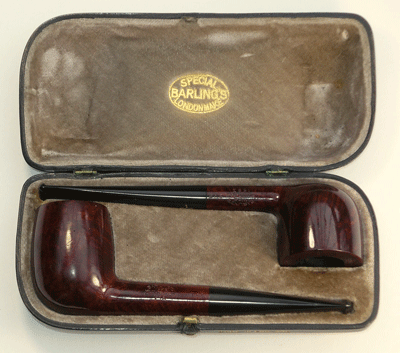
The Company
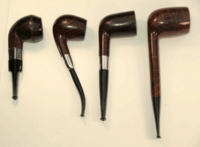
“We have much pleasure in presenting our New Catalogue illustrating some of the principal shapes and specialities in our celebrated EB WB Briar Pipes.
Our pipes being so well known and universally known (without the artificial aid of advertisements), we will not here dwell on their perfection, but would ask you to kindly peruse this book, which will no doubt introduce to you some new patterns.
If you are not already a smoker of our pipes, we hope that it will lead to your giving them a trial and thus testing their quality and workmanship, we ourselves being confident of your ultimate judgment and satisfaction. Every department of our factory being under our own practical and personal supervision, ensures every pipe turned out by us coming under our direct notice. This fact, coupled with the excellence of the materials used in their manufacture, has given our pipes a reputation second to none in the smoking world, a reputation we firmly intend to maintain and strengthen.
B. BARLING & SONS.
London”
- Preface to the first edition of B. Barling & Sons catalogue of pipes - Printed by Unwin Brothers - The Gresham Press - date unknown but typography suggests the mid ‘teens to early 1920’s.
Among collectors of high-grade British pipes, family era Barling pipes are rated at the pinnacle. No other maker enjoys a finer reputation for the legendary quality of their materials, engineering and craftsmanship.
The Barlings were silversmiths in England during the latter part of the 1700's. Sensing an opportunity, Benjamin Barling started outfitting meerschaum bowls with exquisite silver mountings, founding B. Barling and Sons in 1812.
The company received recognition of their work at the Great Exhibition of 1851 for their display of a set of “Silver-mounted meerschaum smoking pipes.” - Official Catalogue of the Great Exhibition of 1851 - page 147. This honor meant so much to the company that they proudly displayed the medallion they received on the cover of their first catalog of pipes decades later.
Over the ensuing years the company gained and maintained an enviable reputation for the excellent smoking characteristics of their pipes, as well as for their unique interpretation of classic shapes, and the development of some "new" classics. Though not the first English company to carve pipes from Briar, (that distinction being given to Loewe’s who first introduced briar pipes to English smokers in 1856 - “Loewe of the Haymarket - 1926) the Barling Company supplied finely wrought silver fitments to briar bowls turned by others.
Among authorities on the Barling pipes, none is more respected, nor better known, than Tad Gage. His article, Mysterious Barlings, written for the Spring 2000 issue of Pipes and Tobacco Magazine, has become the touchstone for collectors worldwide.
Gage believes that the Barling Company did not exclusively turn their own bowls until some time around 1909.
In their single-minded pursuit of perfection, B. Barling and Sons used only the very choicest of old growth air seasoned Algerian briar. “Legendary” is the term most often applied to the smoking properties of these pipes.
- A Beautiful 1917 cased set, courtesy Alex Lee - Scotland
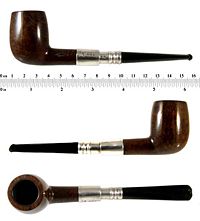
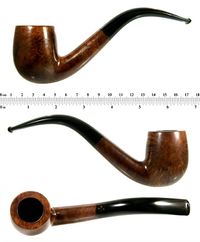

Richard Carleton Hacker is the author of numerous books on collectible and historic pipes including Rare Smoke - The Ultimate Guide To Pipe Collecting. According to Hacker, the Barling family sold the company to the Imperial Tobacco Company in 1960. However, Tad Gage states that the year was 1962. Peter Macnab, writing about the history of the company for Tobacco Magazine in 1982 gives the year as 1961 when B. Barling & Sons was sold to Finlay’s, their largest customer and a part of the Imperial Tobacco group.
Regardless of the year of the sale, the Barling family was running the company in 1962. Montague Barling was still the president of the company and Williamson Barling was still the general manager, a position in which he would continue to1967.
It has recently come to light that letters exist, which were written by Montague Barling from the period of April thru June of 1962, during which time the Barling Company presented pipes to celebrity pipe smokers to celebrate the 150th anniversary of the company. We have included a sample of that correspondence in the form of an exchange of letters between Mr. Barling and Bing Crosby. Montague Barling’s stationery clearly bears the imprint of “President”. On the basis of this evidence we can set aside the 1960 sale date in favor of either late 1961 or 1962.
It’s worth quoting Montague Barling’s letter at this point:
“Dear Mr. Crosby,
During a fleeting visit to Jasper Park late in the summer of 1948 I had the pleasure of having a chat with you. The subject of pipe smoking arose and I well remember your keenness and interest in specimen briars.”
“This has been brought to mind again because my company has collected and made up into Companion Cases, containing two pipes, a few fine specimen Barling Pipes. They have been manufactured in celebration of the One Hundred and Fiftieth Anniversary of the establishment of this business by my Great Grandfather in the year 1812.”
“It is our wish that these should be presented to world famous pipe smokers, and I have taken the liberty of including your name on my list. Would you be kind enough to let me know if you will accept such a presentation?”
B. Barling & Sons, LTD.
Not being stupid, Bing happily accepted the presentation gift.
Montague Barling, in reply, thanked Bing Crosby, presented the 150th Anniversary pipe set and wished him many hours of smoking pleasure from them. In the body of this letter Barling again uses the term “my company”. So in June of 1962, Montague Barling refers to B. Barling and Sons as his company. And who is anyone else to dispute this?
In addition we have included photos of a military bit billiard that has all of the correct “family era” stampings and a 1961 date hallmark. According to a retired Director of B. Barling and Sons, who supplied the correspondence between Montague Barling and Bing Crosby, the year of sale was 1962. So for the purpose of this article the latter date will be applied.
Following the sale of the company change came on gradually. Montague Barling still ran his company. Williamson Barling continued to run the shop as general manager, a position he would hold until 1967. Ron Harden, who worked for Finlays, and whose reminisces provided much of the information to both Mssrs. Gage and Macnab, joined Barling as sales manager in 1964. He later became general manager, and is credited for saving the brand from extinction at the hands of Imperial Tobacco.
The periods
According to current scholarship, the Barling has gone through three distinct periods, which dramatically effect collectability of the pipes. These are referred to as the Pre-Transition, Transition, and Post Transition periods. The "Pre-Transition" pipes are highly sought after by collectors and have excellent smoking and aesthetic qualities. These pipes are famous for the "old wood" from which they were made.
There is also a group of collectors who suggest that there are two Transition periods, based on quality rather than ownership of the company. These collectors hold that there was a noticeable inconsistency in quality beginning around 1954. Transition 1runs from 1954 to 1962 and Transition 2 runs from 1962 to 1968. The problem with this system is that the subtle inconsistencies are not noticeable on pipes that have seen 60+ years of use. It is pretty well ignored by Barling Pipe collectors.
The following pictures of a Barling apple with a sterling military bit also points to a later dating for the change of ownership and nomenclature than Hacker's 1960 date. It clearly shows hallmarks for the year 1961 and yet has all of the other accepted "Pre-Trans" stampings - 3-digit number, arched logo, etc. You can find the hallmark chart at this URL. Look at the entry for 1961 - slightly diagonal lowercase "f" in a beveled rectangular shield. It's a perfect match!
- 1961 Hallmarked Barling, Jesse Silver Collection
The Catalogs
R. C. Hacker states, incorrectly, that B. Barling and Sons issued no catalog prior to 1962. At least two earlier catalogs are known to exist. The preface for the B. Barling and Sons catalog is now included on this page as is a scan of the cover. In addition, Barling issued a brochure illustrating their various lines of pipes in 1957. - http://yeoldebriars.com/barling018.html NOTE: This site is Japanese and we suggest that it be accessed using Google’s translator. There is a wealth of information therein contained. In addition, the unintentional howlers created by the translator will provide a great deal of amusement.
The circa 1922 Catalog
The Barling Catalog presented here was a reference copy that was preserved in the Barling Company’s archives. We cite the 1922 date because a price list, dated 1922, has also turned up in the surviving Barling archives. We hope to be able to provide a reproduction of it at a future date. As you can see, this catalog features beautiful engravings of various shapes. A model name and number accompanies each illustration. The model numbers are 1 digit, 2 digits, 2 digits plus a letter, 3 digits, and 3 digits plus a letter. Cased sets are given the appellation “Special” and are assigned a 4 digit model number, beginning with a 1. Different sizes of the same shape are given unique model numbers that are not related. All illustrated pipes have a military bit, spigot, or sterling band.
We must confess to being amused at the idea of a dashing mustachioed officer of the Queen’s Regiment ordering a “Nymph”.
In addition to the selection of shapes, the catalog includes photos of the Barling Factory, some of which are herein reproduced.
- Samples from the 1922 Barling Catalog
The 1962 150th Anniversary and Retailers’ Catalogs
In 1962 the B. Barling and Sons Company issued not one, but TWO complete catalogs. The differences between these two catalogs are striking enough to warrant comment here. Their contents may legitimize altering the current definition of what constitutes a Pre-Transition, or Family Era, Barling. Or, at the very least, offer a reason to create a new period, Early Transition.
The earlier of these two Catalogs, is the 150th Anniversary Catalogue.
The copy that we have, and from which we have pulled pages for your examination, includes a price list dated June 1962. Thus we can fix a reliable timeframe for this catalog. Remember that at the same time that this catalog was published, Montague Barling was writing to Bing Crosby and other celebrity pipe smokers about gifting them with the finest briars that Barling had ever created. This was all part of the 150th Anniversary celebration, a celebration that had been many years in the making. On page 36, under the heading “Jubilee Companion Set” the following is written:
“For many years, in anticipation of our 150th Anniversary, we have put aside certain bruyere bowls of outstanding merit to be brought to maturity under ideal conditions.”
Under the current definition of a Pre-Transition pipe, these pipes, made from specially aged briar of the finest quality to celebrate the 150th anniversary, are transition pipes because their model numbers are designated as “Transition”. Time for a change?
It is in the 150th Anniversary catalog that the new numbering system first appears. The new numbering system was introduced while the Barling family ran the business. The price list explains that the new number designates size.
All of the pipes pictured in this catalog feature the arched “BARLING’S” over “MAKE” logo stamp. But here’s an interesting fact. Most of the pipes pictured have the old model numbers. Evidently new pictures of the pipes were not commissioned for the catalog, probably because management figured that most people would either not notice, or not care.
But interspersed between these pictures are other pictures of pipes with the new numbering system stamped into the shank. And ALL of those pipes also have the small “BARLING’S MAKE” stamp that was in use during the 1930’s and early ‘40’s. It makes more sense to assume that Barling was reintroducing the small stamp with the revised numbering system than to assume that a large number of unstamped pipes had been hanging around since the 1930’s, including six years of a world war during which time shipments of briar became a much lesser priority and makers were scrambling to find any stock that they could turn into product.
- Barling’s Make pipes with the “transition” model numbers and wide view of the catalog page
The catalog contains a listing of grades. From bottom to top these grades are: standard, sandblast (referred to as “fossil” in the stampings), Guinea Grain, Ye Olde Wood Special, Straight Grain, and Presentation Straight Grain. None of the previously published material from third party sources mentions that there were TWO grades of straight grain!
In November of 1962 B. Barling and Sons published another full catalog. The differences between the two are instructive.
Let’s start with the frontispieces, shown here side by side.
June 1962 - 150th Anniversary Catalog - “During nine Reigns the Barling family have developed and perfected their craft of making the finest quality briar pipes in the world.”
November 1962 - Retailers’ Catalog - “During nine Reigns Barling have developed and perfected the finest quality briar pipes in the world.”
The frontispiece of the Retailers’ Catalog has been remade to remove any direct mention of the Barling family.
The 1962 Retailers’ Catalog introduces a brand new company logo. Gone is the traditional block letter “BARLING’S MAKE”. In its place is a script Barling logo. All pipes pictured in the Retailers’ Catalog are stamped with the new logo. See the examples below. For this reboot of the Barling line of pipes, new photography has been commissioned for all shapes.
The grading system is simplified in the Retailers’ Catalog. There are now 4 grades, standard, sandblast, Garnet Grain, and Guinea Grain.
The numbering system that was introduced in the 150th Anniversary Catalog has been retained. But, the numbers also include a size 1. So, with this new line of pipes we now find 4 digit numbers beginning with a 1.
Based on the fact that the Barling Company felt compelled to produce two markedly different full catalogs months apart in 1962, especially in light of a prior dearth of such publications during 150 years of activity, we have to conclude that a remarkable sea change took place. The change in language on the frontispiece between the two catalogs underlines the nature of that change as the Barling family ceased to lead the company and ceased to be mentioned.
We would suggest that the 150th Anniversary Catalog represents the apotheosis of the family era. And, based on both 1962 catalogs and their contents, we suggest that all pipes which bear the block “Barling’s over “Make” logo should be defined as Pre-Transition regardless of model number. Mel Feldman, the highly regarded expert on Barling, holds this view.
As illustrated in the later 1962 Retailers’ Catalog it is the change of logo to a script “Barling” that begins the post family era and which signifies the era of production to be either “Transition” or “Post-Transition”, not model numbers.
At the very least, these “BARLING’S MAKE” pipes from 1962 should not be grouped with the later product produced under Finlay’s control. If the fraternity of Barling collectors cannot accept these pipes a being pre-transition, then we need a new category, Early Transition.
Pre-Transition 1812 - 1962
The Barling family controlled production up till this point. Quality was excellent, however some sources indicate a marked inconsistency in quality starting as early as 1954.
These pipes were made from old growth “extra extra” grade Algerian briar, of a quality no longer available. Barling conducted their own harvesting operations, looking for roots that ranged from 80 - 150 years of age. While many find the grain to be beautiful, this was not the aim of the Barling Company, and many of their pipes have rather unremarkable grain. The Barling Company’s intent was simple, to create the finest smoking instruments in the history of the world. Many connoisseurs believe that they achieved that goal admirably.
In addition to the smoking qualities of their wood, the Barling Company outfitted their bowls with hand made stems that many consider to be the most comfortable ever created. Their engineering is beyond reproach. Their silver work remains unsurpassed.
As an interesting side note, the soft Algerian Briar was not initially prized, as it was prone to burnout. But Barlng took the time to properly age and season this carefully selected wood for between 3 and 5 years, before finishing. They also made pipes with thicker walls, which helped defend against burnout. The porous mature of this briar in excellent heat dispersion and provided a cool smoke.
Pre- Trans Nomenclature
Before discussing the nomenclature of the Pre-Transition or “family era” pipes it is important to note that there are no absolutes. Barling pipes from this period show a remarkable degree of variation when it comes to nomenclature. The following information can be applied in a general fashion.
According to Tad Gage, Pre-1946 stampings are minimal. No size, shape numbers, or even grading appears on most pipes before World War II. Of course there are exceptions and we have included images of a Barling pipe with 1922 hallmarks that clearly shows an “EL” stamp and a “MADE IN ENGLAND” stamp. While one is tempted to speculate that the sterling olive could have been placed on a much later pipe, the “BARLING’S MAKE” stamp is correct for this period.
- 1922 hallmarked pipe with the “EL” stamping, Jesse Silver Collection
Many Barling pipes made prior to 1909 lack any company markings except for the name of the shop that sold them. The only stamp that tells us that the pipe is a Barling is the sterling makers mark “EB” over “WB”. It is common to find only a small "BARLINGS MAKE" stamped in block capital letters, with an arched BARLING’S over MAKE. Many of the older pipes feature sterling silver fitments, which make dating a simple mater of looking up London hallmarks, and the "EB WB" makers’ mark.
According to Gage, Barling did not turn most of their bowls, but provided silver fitments for bowls turned by others.
At some point during the final decade of the 19th century a “BARLING’S MAKE” logo begins to be occasionally stamped on the pipes in addition to the Dealer stamp. This logo consists of an arched “BARLING’S” over the word “MAKE”, in block letters, and will eventually appear on all Barling pipes, with the notable exception of the Guinea Grain grade, and the CYG-SMOKER until the sale of the company.
An interesting briar calabash shape from 1908 features the dealer’s name on the LH side with the “BARLING’S MAKE” stamp on the verso in a secondary placement. Since Gage suggests that the Barling Company didn’t begin exclusively turning its own bowls until some time around 1909, this may represent one of the earliest pipes made entirely by the Barling Company. Instead of the famous “MADE IN ENGLAND.” the word “ENGLND” is placed below the “BARLING’S MAKE” stamp. There is no crossed Barlings logo on the stem.
- 1908 Calabash Shaped Briar Pipe, Jesse Silver Collection
Sometime around 1913, the “Ye Olde Wood” stamp makes its appearance on selected pipes. An example exists stamped on a 1913 date hallmarked pipe. This logo will continue to be used in the decades to come. Eventually, “Ye Olde Wood” will be stamped on nearly every pipe made and will come to represent the company to the world.
It is not known when the crossed Barling stem logo first appeared, but an example exists on a pipe with a 1923 date hallmark. During the 1930’s the “Barling’s Make” logo undergoes a style change, smaller in size with simpler block lettering. Model numbers will occasionally be stamped below the logo. These model numbers may be 4 digits beginning with a 1 for the English and European market. For the “overseas” market 3 digits, 2 digits and a letter, or 2 digits will be used. The “MADE IN ENGLAND.” stamp is also in use. As with all things related to the Barling nomenclature there are variations. Sometimes there is no “MADE IN ENGLAND.” stamp. Examples exist with a “MADE IN LONDON” over “ENGLAND” stamp. And, there are examples with “MADE IN ENGLAND” with no period after the word “ENGLAND”.
In the ‘1920’s the Barling Company experimented with an aluminum tube pipe called a “trotube”.
- 1927 Tro-Tube quaint, A striking example of a spectacularly rare pipe, courtesy Kevin Chapman via Jesse Silver
In the 1930’s Barling produced a different line of filter pipes called the Pipet.
Later the Pre-Transition company made a line of filtered pipes called the “CYG-Smoker”. The CYG-SMOKER line of pipes also used the same script logo as appears on the Guinea Grain grade of pipes.
- The Cyg Smoker, a filtered pipe that Barling produced, Courtesy Douglas Holloway via Jesse Silver
A script “Barling’s” logo is used for the Pre-Transition Guinea Grain grade. In addition to the script “Barling’s” logo the pipes hare an “EB” and “Regd” stampings.
And, horror of horrors, there are a few Pre-Transition pipes that have a script “Barling” logo.
Also according to Tad Gage, the only four-digit number that denotes a Pre-Transition piece begins with "1," which was used for pipes sold in England. Any other four-digit Barling pipe is a Transitional piece-- (Tad Gage in P & T magazine). Pipes intended for non-European markets have a 3-digit number. However, Pre-Transition Barlings may have two numbers, not just three, and they may also have a letter following the model numbers. For example, the letter “M” following a model number could indicate that the bowl is meerschaum lined.
Also, Gage also cites a possible exception to this model number rule, which will be pointed out in the section concerning Transition nomenclature. We should add that based on the examination of the two 1962 catalogs we believe that the definition of a Pre-Transition piece should be based on the use of the block “BARLING’S MAKE” logo and not the model numbers.
Following the Second World War the Barling Company developed an array of descriptive stampings. Added to the famous “Ye Olde Wood” were other descriptors such as “TVF” (the very finest), “Special” - a designation for pipes with better than average graining, “Fossil” - a designation for sandblasted pipes, Straight Grain, and Birdseye - for pipes exhibiting exceptional birdseye.
Size stampings come into common use as well. There are some variations cited in the range of size stampings, but the following are given with the understanding that this may be revised based on input from knowledgeable collectors. The sizes, going from the smallest to the largest, are as follows: SS, S, S-M, L, EL, EXEL, EXEXEL, and G.
Following the War, the small “BARLING’S MAKE” logo was discontinued and a larger logo was used. The larger logo would continue to be in use until 1962, when the 1930’s style logo was reintroduced along with the new numbering system.
Model numbers, the so-called “Nichols” numbers came into common use. For the non-European market these consisted of 2 and 3 digit model numbers and sometimes also included a letter at the end. Pipes intended for the European market had four digit model numbers that began with a numeral 1.
Pre- Trans Grades
Pre-Transition pipes come in a number of grades: Standard Standard Ye Olde Wood - sometimes referred to by collectors as YOW, which may have a dark or plum stain - TVF may be a slightly higher grade of YOW Ye Olde Wood Special - pipes with a nicer grain figure and which are left natural rather than stained dark Birdseye - pipes with particularly nice Birdseye grain - one of the rarest of Barling stampings Guinea Grain - something between a flame grain and a straight grain - these pipes have a script “Barling’s” logo. They were also oil treated to bring out the contrast in the grain. Straight Grain - Barling’s highest grade - these don’t have model numbers. Presentation Straight Grain - the rarest of the rare - an EXEXEL size would have sold for $7500.00 in today’s dollars!
In addition, in a category all by themselves, are the Quaints. The Barling family prided themselves on producing flawless pipes with no fills or sand pits. In some cases, pipes with flaws would get a sandblast. Occasionally a pipe with exceptional grain, usually a straight grain, but flawed with a pit, would be hand carved into a wonderful and unique work of art. The bowl would be carved into panels, and/or fluted, and the offending areas would be covered with delicate traceries of a pleasing symmetrical design. No two are exactly alike. Each Quaint is a unique hand carved pipe. The Barling Company did not designate these pipes as “Quaints”. They were simply hand carved pipes. But, reflecting the work involved in their carving, these were priced at the same level as the straight grains.
- A beautiful Quaint, courtesy Jesse Silver Collection
Pre- Trans Shapes
The Barling Company produced a variety of classic English shapes of every description. It has been written that they primarily produced billiards and pots because Montague believed that Peterson had a lock on the bent market, and Charatan dominated in the area of Dublin shapes. But their catalogs, including the 1922 catalog, show a wide assortment of shapes including pages of bents, dublins, bulldogs, and other classical shapes. Barling produced shapes of all description and constantly experimented with variations. That’s part of the fascination. As if this isn’t enough variety to keep the collector entertained, the Barling Company crafted numerous custom pipes on special order for their clientele. Special orders lack model numbers because they are not standard models.
Transition Period - 1962 - 1969
Early Transition
Occasionally one sees a Barling pipe for sale whose owner claims it to be an “early transition” piece. The stampings look exactly the same as any other transition piece, with a script Barling logo and London England in block lettering underneath. So, how to tell? Some very experienced collectors claim to be able to recognize the wood as being of Pre-Transition origin, while others claim that it’s the feel of the para-vulcanite stems. But for the vast majority there is no obvious method of identification.
The only subset of pipes that can clearly claim this distinction, barring their acceptance as Pre-Transition pipes, are those “Barling’s Make” pipes made in 1962 after the new numbering system was established. These, and only these, pipes can be clearly dated to a specific period because of the two 1962 Barling catalogs that bookend the period. As for the pipes made with the new script logo, it’s a guess at best.
Some of these pipes have a TVF stamp, and this is where Gage makes an exception to his model number rule. Since the TVF stamp was added prior to the finishing of the bowls, Gage identifies these pipes as Pre-Transition pieces.
Other Barling experts believe that all of the pipes that have the old arched block logo were made before the sale of the company and as such are Pre-Transition pieces regardless of the model number stamping. The respected Barling authority, Mel Feldman, who owned, handled, and sold thousands of Barling pipes, held that ALL “BARLING’S MAKE” pipes were Pre-Transition pieces.
So one’s definition as to whether these particular pipes should be classified as Pre-Transition versus early Transition pieces relates directly to whether to classify by the company’s own published materials or not.
However one chooses to define them, these pipes will have the same smoking characteristics as the accepted Pre-Transition pipes for a fraction of the price, at least, for now.
Transition
Late in 1962 Barling issued the Retailers Catalog featuring new photography of the revised product line. These pipes feature a script Barling logo with no apostrophe and no letter “s”. It’s frontispiece jettisons mention of the Barling family and replaces it with just Barling, a brand name to be associated with the other various brands of the Imperial Tobacco group.
Initially, Finlay’s management used the remaining stock of bowls that were turned by the original family run company, and then proceeded to turn more bowls with old wood remaining in inventory, and at least initially, this work was performed by many of the same craftsman. Under Finlay’s management the factory continued to turn out a quality product. Production was expanded to produce a greater number of own name brands for Finlay and Bewlay, as well as the production of pipes for other pipe firms such as Colibri, Falcon, and Ronson. Also, several lines of “seconds” were developed, amongst them Portland, BB & S, Cragmoor, and London Brand.
Transition Nomenclature
Besides discarding old size nomenclature, the TVF stamp was largely discarded by Finlays. The “MADE IN” over “ENGLAND” stamp was discontinued. Instead, the words “London England” were added under the script Barling logo. Gone too, was the ubiquitous “Ye Olde Wood” logo that symbolized so much of the old company’s philosophy.
As previously stated, the later 1962 Retailers Catalog, distributed in November, clearly shows that a new logo is in place, a script “Barling”. So by late 1962 no more pipes are being stamped with the old arched block “Barling’s Make” logo. The introductory page is herein reproduced below and as you can see, it refers to 150 years of pipemaking
The 1962 Retailers’ Catalog listed four grades: Standard, Sandblast, Garnet Grain, and Guinea Grain. Though not listed in the catalog, the “special” grade continued to be produced in limited quantities.
The four-digit model system introduced earlier in the year was retained with the addition of model numbers that began with a 1 for size 1.
Guinea Grain nomenclature change The Transition version of the Guinea Grain is easily distinguished from the Pre-Transition pipe by the change to the logo. A Pre-Transition Guinea Grain has a script “Barling’s” logo. A Transition (and later) Guinea Grain has a script “Barling” logo. No apostrophe and no “s”.
Quaints continued to be made during this period. The initial Quaints continue the tradition. But at some point a decision was made to institute a line of Quaints, a half dozen or so repeated designs that are not unattractive but represent a faint ghost of the originals.
Post Transition Period and Nomenclature
By 1970, the range of products had expanded to such an extent that Imperial Tobacco decided to reassign the Barling operation to its Ogden branch. About the same time the two Barling factories at Park Street and Jeffrey Place were closed down and the production of Barling pipes was outsourced to independent pipemakers. After a year or so, operations were transferred to Ogden’s Liverpool factory. Production of Barling pipes was shifted to several Danish firms, amongst them Eric Nording.
Eventually the Barling product was broken into four ranges:
The Londoner Pipe Range, which was a lower priced line that was produced in two finishes, Standard and Sandblast.
The Original Pipe Range, which continued the Guinea Grain, Standard (which replaced the Garnet Grain designation), and Sandblast finishes, while adding the Vintage finish.
The Meerschaum Pipe Range, which were produced in four finishes, Polished, Golden Emperor, Regency, and Bruno.
The Presentation Pipe Range, which was a high-grade line of pipes, each individually handmade, featuring very well grained briar, and excellent engineering. Whatever your opinion of Barling pipes from this period, the Presentation Range offers a very agreeable smoking experience.
- Presentation Straight Grain EXEXEL, Courtesy Yuriy Novikov
Despite these attempts to diversify the line, Barling lost its market. These pipes just weren’t equivalent to the family era pipes. Finally, Imperial decided to close down the Barling operations entirely by 1980. It was at this point that Ronald Harden, general manager of Barling, stepped in to attempt to save the brand from extinction. Through the efforts of Mr. Harden, Bucktrout and Company bought the rights to the Barling name and at this point operations were moved to the Isle of Man with Mr. Harden as chairman. The company was renamed Barling Pipes Ltd. From that point on, the goal was to restore the old tradition of pipemaking from the family era. New equipment was installed and pipes were made following the Pre-Transition patterns. In 1980, rather than becoming a footnote in pipemaking history, the new line of Barling pipes was introduced.
Some of the Pre-Transition nomenclature was restored, such as the old SS thru EXEXEL size system even though the pipes continued to be stamped with a 4-digit number that also included a size designation. The use of a “Barling’s Make” block letter logo was reintroduced on some pipes, though the logo is on one line with no arched lettering. And both the “Ye Olde Wood” and “TVF” stamping was brought back. Since then Barling has re-established itself in England as a quality mid level pipe.
Summation
Excellent pipes were made in all periods. But the fine old growth Algerian briar that was used by the family during the Pre-Transition Period offers a smoking experience that is not duplicated during the later periods. Moreover, it is not duplicated by any other maker. Legends cannot be copied. Legends are unique.
The original Barlings were silversmiths in England during the latter part of the 1700's, with their silver mountings first appearing on pipes in 1812. The following Gallery photos are of a "Kalmasch" (German style) meerschaum carved in Vienna with silverwork done by Benjamin Barling (marked BB) in London, hallmarked 1850. From the Johnny Long Collection. Hallmark was authenticated by silver expert Giorgio Busetto, secretary of the ASCAS (silver association [[3]]). This 1850 meer will be featured in the ASCAS newsletter in May 2010.
Sources
- Rare Smoke, Volume 1, by Richard Carleton Hacker
- Pipe.org forum discussions
- Several A.S.P posts Michael Lindner, Mel Feldman, and others.
- Tad Gage article, Mysterious Barlings, pg.40, Spring 2000 edition of Pipes & Tobacco Magazine.
- Pipemakers with an unrivalled Reputation: The Barling Story, by Peter Macnab, Tobacco Magazine, November 1982
Sources to check
- 1922 Barling Catalog
- 1962 Barling 150th Anniversary Catalog
- 1962 Barling Retailer Catalog
- "A smoker's guide to Barling" by Tad Gage in "Pipe Friendly" vol. 1, # 3 pp. 7, 1995.
Misc. photos to possibly intigrate
- Note the beautiful deep blast on this Pre-War custom shaped sandblast, courtesy Jesse Silver Collection
- Plates from 1957 Brochure
- I believe these appear to be mostly transition and post transition pipes?
